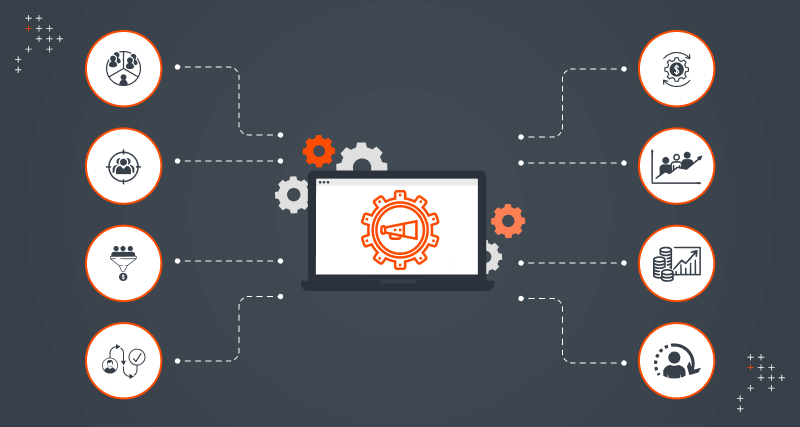It feels safe to rely on referrals. They’re warm leads, they come with trust, and they make you feel like your network is working for you. But here's the problem, referrals alone can’t scale your startup.
You’re not alone if you feel like you’re stuck in the referral rut. Many tech startups struggle to find reliable growth channels.
Referrals are unpredictable. While they may keep the lights on for now, they won’t power your long-term growth. If you’re serious about scaling, you need a system that delivers consistent, high-quality leads, a predictable revenue engine.
In this post, we’ll walk through how to stop relying solely on referrals and build a sustainable lead generation model that aligns your marketing and sales efforts.
Why Referrals Are Holding Your Growth Back
Referrals, while valuable, leave you vulnerable to fluctuating business. As Alexander Boswell, Founder/Director of SaaSOCIATE says, relying too much on any one lead source is risky. When referrals slow, so does your revenue.
Referrals might seem like an easy and affordable way to bring in clients, but they come with hidden downsides. Over-relying on them can stall your marketing efforts and limit your ability to grow beyond your current network. Let’s look at the main pitfalls of relying heavily on referrals:
1. Inconsistent Lead Flow
Referrals are irregular by nature, making it hard to predict when or if you’ll get new clients. As highlighted by Pratrick Dilon, Forbes Agency Council, word-of-mouth alone can create highly volatile revenue streams. This unpredictability stunts growth potential and makes financial planning difficult.
2. Limited Market Reach
Referrals typically come from a closed network, limiting your ability to tap into new markets or industries. And this is not new, an age-old research by Shar VanBoskirk,Principal Analyst from Forrester showed that agencies expanding their marketing efforts, especially through digital strategies, are more likely to reach broader, higher-growth markets. Relying on your current circle stifles the discovery of new opportunities.
3. Lack of Control Over Revenue
Without control over your lead generation pipeline, forecasting revenue becomes a guessing game. You can't scale predictably if you're waiting for your next big client to walk in the door. There is a need for balanced, multi-channel lead generation strategies to ensure steady, predictable revenue growth.
The Problem With Your Marketing Approach
Why do most startups struggle to move beyond referrals? It often comes down to a lack of strategic focus. Startups jump into marketing without a clear plan, throwing money at campaigns without truly understanding their Ideal Customer Profile (ICP) or where their customers are most active.
Challenges
- Lack of Strategic Focus: Marketing efforts are often scattered across channels without a unified approach.
- Ineffective Content Distribution: Content isn’t reaching the right audience at the right time.
- Missed Opportunities for Deeper Customer Engagement: Failing to engage potential customers where they’re most active limits your reach and impact.
The Solution: Building A Sustainable Revenue Engine
Sustainable growth isn’t just about having great products. It’s about being smart with how you reach the right people and deliver value.
At Axelerant, we took a different route from the usual content treadmill by adopting an Agency Marketing Framework that transforms content into a true revenue driver, not just something that clogs up your digital channels.
Who are we really talking to?
We narrowed our focus to understand our audience inside out. Instead of creating for “everyone,” we zeroed in on specific personas who actually care.
What problem are we solving?
Every piece had to address a real challenge or need, ensuring that what we published was not just seen but valued.
How does this content fuel our growth goals?
Each content effort mapped back to a revenue objective, ensuring everything we created had a direct role in driving growth.
Crafting A Content Production Engine
- Centralised Foundation: We established a system for producing content, backed by stakeholder interviews to keep us aligned with both internal goals and market trends.
- Proactive Content Calendar: By curating a topic repository and collaborating with different teams, we consistently delivered timely, relevant content that tackled high-impact issues.
- Repurposing for Maximum Reach: We don’t just publish and pray. Each piece is repurposed to live across multiple platforms, what starts as a blog morphs into a video, a LinkedIn post, or an email campaign.
Bringing Content To Life
- Strategic Distribution: We shared content where it would actually be seen. We went multi-platform and got laser-focused on channels where our audience spends time.
- Iterative Refinement: Based on real feedback, we continuously tweaked our approach to keep content relevant and engaging.
Here’s how you can ensure marketing efforts align with business objectives:
Step 1: Know Who Your Ideal Customer Is
The foundation of effective marketing and sales alignment starts with defining your Ideal Customer Profile (ICP). Who are your most valuable customers? What are their challenges, pain points, and industries? Narrowing down your ICP is critical to targeting your efforts where they’ll make the most impact.
Pro Tip: Create a data-driven profile of your ICP. The more specific you can be, the better you can target your messaging and outreach.
Step 2: Know Where Your Customers Are Active
Once you’ve defined your ICP, understand where they spend their time. Are they on LinkedIn, niche forums, or reading industry-specific blogs? Your marketing efforts need to be laser-focused on the platforms where your customers are already active. McKinsey & Company explains that companies excelling in customer engagement and personalization can see up to 40% faster revenue growth.
Example: For a B2B startup, LinkedIn might be the primary hub for professional networking, while a SaaS company might see more traction in tech forums or Reddit threads.
Step 3: Know How To Engage Them
Building a scalable lead generation system isn’t just about finding where your potential customers are. It’s about knowing how to engage them in ways that foster trust, add value, and inspire action. A balanced approach combining both inbound and outbound marketing, along with strategic partnerships and community-building efforts, can transform how you connect with your audience. Here’s how to make it happen.
Inbound Marketing For Long-Term Growth
By positioning your brand as a thought leader, you can earn the trust of your audience and build credibility over time. This approach helps you cultivate relationships with prospects who are more likely to become loyal customers, ultimately lowering your customer acquisition costs and increasing lead quality.
How to Do It Right
- Showcase Your Expertise Through Content: Create content that highlights your solutions to real-world problems. Share case studies, success stories, and client testimonials to demonstrate your capabilities.
- Target Every Stage of the Funnel: Tailor your content to guide prospects through their buyer’s journey. Use blog posts, white papers, and webinars for the awareness stage, case studies and product demos for the consideration stage, and customer testimonials and free trials for the decision stage.
- Nurture Leads with Automated Workflows: Implement email sequences that educate, inform, and engage leads based on their behavior and interests. This personalized approach helps move prospects closer to making a purchase decision.
Outbound Marketing For Quick Wins
Outbound tactics can help you achieve faster results by reaching out directly to potential customers. Outbound strategies, such as cold outreach, targeted PPC ads, and remarketing campaigns, allow you to take control of your pipeline by going after high-potential prospects.
Effective Outbound Tactics
- Cold Outreach: Whether through emails or phone calls, direct outreach can quickly introduce your brand to targeted prospects. Make it personalised and relevant to increase engagement rates.
- Targeted Advertising: Leverage social media ads and Google Ads to reach audiences based on their interests, behavior, and search queries. Use retargeting to stay top-of-mind for prospects who have shown interest in your brand.
- Account-Based Marketing (ABM): Focus on high-value accounts with customized messaging and offers. This targeted approach can deliver significant returns on investment by closing deals with key prospects.
Grow Through Strategic Partnerships
Strategic partnerships offer a powerful way to expand your reach and diversify your lead generation efforts. By collaborating with complementary businesses or industry influencers, you can access new customer pools and gain credibility faster.
How to Leverage Partnerships
- Co-Marketing Opportunities: Partner with businesses that share a similar target audience but offer different products or services. This allows you to co-create content, run joint webinars, or share promotional offers to mutually expand your reach.
- Marketplace Integrations: If you’re a SaaS company, consider integrations with other popular tools in your industry. Being featured in another company’s ecosystem can expose you to new users and create seamless product experiences.
Go Beyond Building And Engage Your Community
Find a community and foster active, value-driven participation. Create a deeper, more authentic connection with your audience. Not only do communities foster trust, but they also generate leads organically by word-of-mouth.
Strategies for Community Building
- Participate in Industry Discussions: Engage with relevant communities on forums, LinkedIn groups, or social media platforms. Offer insights, answer questions, and share valuable content to establish your brand as a thought leader.
- Host Interactive Events: Organize webinars, Q&A sessions, or roundtable discussions to foster a dialogue with your audience. These events can generate valuable feedback, spark ideas for future content, and build lasting relationships.
- Content for Community Engagement: Create content that encourages interaction, such as polls, surveys, or contests. Use storytelling to resonate with your audience and invite them to share their experiences or opinions.
Relying on referrals alone can only get you so far. To scale your startup and build a predictable revenue engine, it’s essential to diversify your lead generation efforts.
Want to know how? Let’s chat! Schedule a call today to see how we can help your startup build a scalable, predictable revenue engine.
Do not forget to read our diversification case study given below! read more about us here.
The Axelerant Story
From Niche Beginnings To Growth Constraints
Axelerant started small, with a team of around 20-30, sustained by a steady stream of referrals within the Drupal CMS ecosystem. Born into this open-source, community-driven world, our work primarily focused on CMS builds and migrations. Referrals brought clients from the higher ed and nonprofit sectors, industries where Drupal is strong. While this provided stability, it also pigeonholed us. We were essentially in a PHP-centric "echo chamber," taking on repetitive projects within a narrow tech stack. This tunnel vision limited our revenue streams and risked stunting our growth.
The Reality Of Over-Reliance
Early on, our dependence on referrals and the Drupal ecosystem exposed us to market shifts within that niche. Our narrowly defined Ideal Customer Profile (ICP) made sales easier, but it also heightened our vulnerability to changes in the Drupal sector. While we served some WordPress clients, we couldn’t shake off the strong bias toward Drupal, which limited our resilience to downturns in that specific tech stack. Diversification wasn’t just a growth opportunity; it was a necessity for survival.
The Strategic Shift: A Three-Pronged Approach To Growth
To secure a path forward, Axelerant adopted a multi-channel growth strategy focused on three areas: outbound outreach, inbound marketing, and community engagement.
Outbound Marketing Misfires
Our first attempt at outbound marketing was a learning experience. We launched a cold email campaign targeting potential clients in adjacent networks, but it fell flat. The Drupal community wasn’t receptive to cold outreach, and our emails were perceived as spammy. At one point, we even had to apologize to a C-level contact for overly persistent follow-ups. Although that organization eventually became a valued partner, the campaign damaged our reputation. Lesson learned: outbound only works if you understand the market’s sensitivities.
Community Engagement: A Double-Edged Sword
Our "community-first" approach aligned Axelerant with influential open-source events, fostering strong connections. One pivotal moment came when a technical lead presented at a strategic event, leading to a partnership with Blue State, a prominent digital agency. This opened doors to collaborations with big-name clients like the United Nations and Doctors Without Borders, eventually resulting in an award-winning case study. However, this strategy kept us tethered to the Drupal community, limiting our ability to fully diversify.
Inbound Marketing Pays Off
To broaden our reach, we invested in inbound marketing, revamping our website, creating high-value content, and publishing case studies. It took over a year to see a consistent flow of quality leads, but the payoff was clear. Inbound brought in clients from sectors as diverse as healthcare, higher education, wellness, and politics. Recently, we’ve collaborated with MIT, Ironman Triathlon, Pepperdine University, and others, offering services across development, design, and marketing automation. Inbound helped us diversify and grow beyond our initial niche.
Redefining Our ICP: Becoming An Agency For Agencies
Our partnership with Blue State revealed an opportunity: positioning Axelerant as an "agency for agencies." By narrowing our ICP to serve other digital agencies, we paradoxically expanded our reach, as these partnerships brought in projects across multiple industries. This shift allowed us to leverage cross-platform expertise while reducing our dependence on any single sector.
Bottom Line: Diversify Or Die
Axelerant’s journey underscores a hard truth for agencies: relying solely on referrals will limit growth. Referrals may drive initial momentum, but without a deliberate, multi-channel strategy, growth becomes stagnant. To build a resilient agency, you need diversified revenue streams, a refined ICP, and continuous evolution. After all, choosing not to diversify is just choosing a slow path to decline

Saakshi Dutta, Marketing Associate
A free-spirited and eccentric explorer, Saakshi brings fresh perspectives to every endeavor—continually looking up at the stars and pushing boundaries. She is passionate about photography, filmmaking, and trekking, always eager to discover new places and tell stories that often go unheard.

 We respect your privacy. Your information is safe.
We respect your privacy. Your information is safe.



Leave us a comment